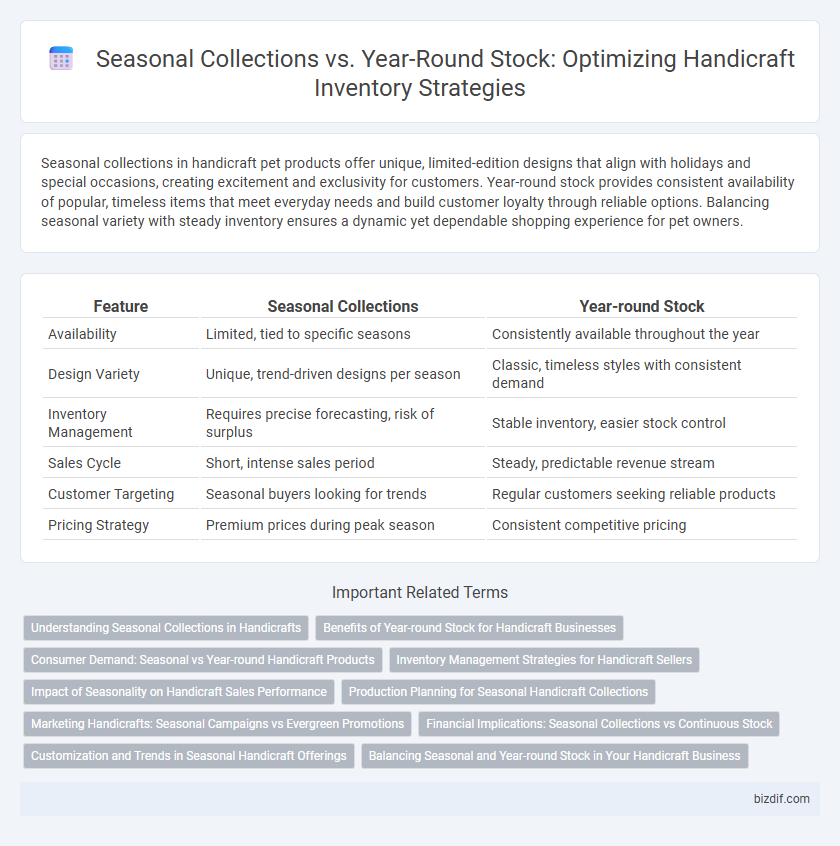Seasonal collections in handicraft pet products offer unique, limited-edition designs that align with holidays and special occasions, creating excitement and exclusivity for customers. Year-round stock provides consistent availability of popular, timeless items that meet everyday needs and build customer loyalty through reliable options. Balancing seasonal variety with steady inventory ensures a dynamic yet dependable shopping experience for pet owners.
Table of Comparison
| Feature | Seasonal Collections | Year-round Stock |
|---|---|---|
| Availability | Limited, tied to specific seasons | Consistently available throughout the year |
| Design Variety | Unique, trend-driven designs per season | Classic, timeless styles with consistent demand |
| Inventory Management | Requires precise forecasting, risk of surplus | Stable inventory, easier stock control |
| Sales Cycle | Short, intense sales period | Steady, predictable revenue stream |
| Customer Targeting | Seasonal buyers looking for trends | Regular customers seeking reliable products |
| Pricing Strategy | Premium prices during peak season | Consistent competitive pricing |
Understanding Seasonal Collections in Handicrafts
Seasonal collections in handicrafts highlight unique designs inspired by specific festivals, holidays, or natural cycles, driving customer engagement through limited-time offerings. These collections often incorporate materials and motifs relevant to the season, such as autumn leaves or winter themes, enhancing their appeal and exclusivity. Understanding the cultural and market trends behind seasonal collections helps artisans create timely, relevant products that boost sales during peak periods.
Benefits of Year-round Stock for Handicraft Businesses
Year-round stock in handicraft businesses ensures consistent cash flow by offering customers constant access to unique handmade products, boosting customer loyalty and satisfaction. It allows artisans to optimize production schedules, reduce inventory costs, and better forecast demand through steady sales data. Maintaining a diverse, always-available collection supports brand reputation and helps businesses adapt quickly to market trends without relying solely on seasonal spikes.
Consumer Demand: Seasonal vs Year-round Handicraft Products
Seasonal collections in handicraft attract consumers seeking unique, timely items that align with holidays or cultural events, driving spikes in demand during specific periods. Year-round stock offers consistent availability, catering to customers who prefer classic, versatile crafts irrespective of season, ensuring steady sales. Consumer demand fluctuates with cultural trends and individual preferences, making a balanced inventory strategy crucial for sustained business growth in the handicraft market.
Inventory Management Strategies for Handicraft Sellers
Handicraft sellers optimize inventory management by balancing seasonal collections with year-round stock to meet fluctuating demand and maintain cash flow. Seasonal collections capitalize on peak buying periods like holidays or festivals, requiring precise forecasting and limited batch production to minimize excess inventory. Maintaining year-round stock of popular items ensures steady sales and customer retention, supported by real-time inventory tracking and adaptive restocking strategies.
Impact of Seasonality on Handicraft Sales Performance
Seasonality significantly affects handicraft sales performance, with seasonal collections often generating higher demand during specific holidays or cultural events, driving increased revenue in those periods. Year-round stock provides consistent availability, catering to steady customer interest but may experience lower peak sales compared to seasonal items. Understanding consumer purchasing patterns tied to festive seasons allows artisans to strategically time production and inventory, optimizing profitability.
Production Planning for Seasonal Handicraft Collections
Efficient production planning for seasonal handicraft collections requires precise demand forecasting to align inventory levels with fluctuating consumer interest during peak periods. Artisans must balance resource allocation and lead times to avoid overproduction while ensuring timely availability of unique, handcrafted items that capture the seasonal theme. Integrating flexible workflows and supplier coordination supports scalability, maximizing profit margins and minimizing waste in seasonal product lines.
Marketing Handicrafts: Seasonal Campaigns vs Evergreen Promotions
Seasonal collections in handicrafts capitalize on timely themes and cultural events to drive urgency and exclusivity, enhancing customer engagement during peak periods such as holidays and festivals. Year-round stock supports evergreen promotions, providing consistent brand presence and stable sales by catering to ongoing demand for artisanal products like handmade pottery and woven textiles. Effective marketing balances limited-edition seasonal launches with ever-available handcrafted items, optimizing revenue cycles and brand loyalty in the artisanal market.
Financial Implications: Seasonal Collections vs Continuous Stock
Seasonal collections in handicraft often require significant upfront investment in design and production, leading to higher inventory risks and potential cash flow challenges during off-peak periods. Year-round stock stabilizes revenue streams by maintaining consistent product availability, reducing storage costs related to unsold limited-edition items. Financially, businesses must balance the increased marketing and production expenses of seasonal lines against the steady, predictable costs and income generated by continuous stock.
Customization and Trends in Seasonal Handicraft Offerings
Seasonal collections in handicraft emphasize timely customization, reflecting current trends and cultural motifs that resonate with specific festivities or periods. Year-round stock focuses on classic designs and versatile items, offering consistent availability but less adaptation to seasonal shifts. Craft artisans leverage seasonal trends to create limited-edition pieces that enhance personalization and appeal, driving customer engagement through exclusivity and cultural relevance.
Balancing Seasonal and Year-round Stock in Your Handicraft Business
Balancing seasonal collections with year-round stock in your handicraft business ensures consistent cash flow while capitalizing on festive demand peaks. Offering limited-edition seasonal items creates urgency and exclusivity, attracting repeat customers and boosting brand loyalty. Maintaining a core selection of evergreen handicrafts guarantees steady sales and appeals to a broader audience beyond seasonal trends.
Seasonal Collections vs Year-round Stock Infographic

 bizdif.com
bizdif.com